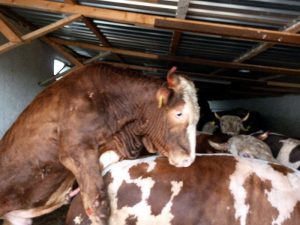Escherichia coli O157:H7 is a major food safety concern for the beef industry. Several studies have provided evidence that cattle hides are the main source of beef carcass contamination during processing and that reductions in the E. coli O157:H7 load on the hides of cattle entering processing facilities will lead to reductions in carcass contamination. Bacteriophages have been proposed as a novel preharvest antimicrobial intervention to reduce the levels of E. coli O157:H7 on cattle hides.
 The objective of this study was to evaluate a commercialized phage application administered in the lairage area of commercial beef processing plants for the ability to reduce E. coli O157:H7 contamination of cattle hides and carcasses. Cattle lots either received phage spray treatment (n = 289) or did not (n = 301), as they entered the lairage environments in two separate experiments at two different commercial beef processing plants. Hide and carcass samples were collected and analyzed for E. coli O157:H7 prevalence and concentration. Cattle hides receiving phage treatment had an E. coli O157:H7 prevalence of 51.8%, whereas untreated hides had a prevalence of 57.6%. For carcass samples, the E. coli O157 prevalence in treated and untreated samples was 17.1% and 17.6%, respectively.
The objective of this study was to evaluate a commercialized phage application administered in the lairage area of commercial beef processing plants for the ability to reduce E. coli O157:H7 contamination of cattle hides and carcasses. Cattle lots either received phage spray treatment (n = 289) or did not (n = 301), as they entered the lairage environments in two separate experiments at two different commercial beef processing plants. Hide and carcass samples were collected and analyzed for E. coli O157:H7 prevalence and concentration. Cattle hides receiving phage treatment had an E. coli O157:H7 prevalence of 51.8%, whereas untreated hides had a prevalence of 57.6%. For carcass samples, the E. coli O157 prevalence in treated and untreated samples was 17.1% and 17.6%, respectively.
The results obtained from these experiments demonstrated that the treatment of cattle hides with bacteriophages before processing did not produce a significant reduction of E. coli O157:H7 on cattle hides or beef carcasses during processing.
Evaluation of bacteriophage application to cattle in lairage at beef processing plants to reduce Escherichia coli O157:H7 prevalence on hides and carcasses
Arthur Terrance M., Kalchayanand Norasak, Agga Getahun E., Wheeler Tommy L., and Koohmaraie Mohammad
http://online.liebertpub.com/doi/abs/10.1089/fpd.2016.2189
